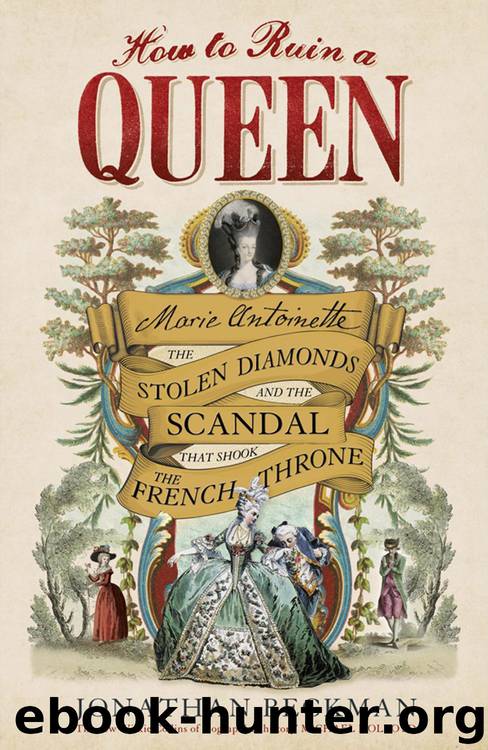How to Ruin a Queen: Marie Antoinette and the Diamond Necklace Affair by Jonathan Beckman

Author:Jonathan Beckman [Beckman, Jonathan]
Language: eng
Format: epub
ISBN: 9780306823565
Publisher: Da Capo Press
Published: 2016-04-11T16:00:00+00:00
18
Questions, Questions
11 January 1786
A FREEZING ROOM in the Bastille. On one side of the table, Titon, still snivelling and tetchy from the cold that had delayed the interrogations. On the other, Rohan, outwardly defiant, inwardly a wormery of nerves. Frémin, the clerk, hunched over a pile of blank sheets of paper, was poised for dictation.
‘What is your name, surname, age, rank and address?’ asked the magistrate.
‘I am Louis-Réné-Edouard, cardinal de Rohan, prince-bishop of Strasbourg, grand almoner of France, aged fifty-two, living in Paris, vieille rue du Temple, the Hôtel de Strasbourg.’
‘On 24 January 1785, were you not at the house of Boehmer and Bassenge?’
Rohan did not answer the question. Instead, he raised objections to being tried by the parlement. As a priest, as a prince of the Holy Roman Emperor, as grand almoner and as a cardinal, he deserved a court of his peers. The choice presented to him by the king had been nothing but coercion, since he had already been deprived of his liberty and was unable to claim the rights of his offices. Having registered his objections, Rohan then began a lengthy disquisition, detailing his relationship with Jeanne from their introduction by Madame de Boulainvilliers. The strategy of reciting a statement had been devised by Target to prevent Rohan confusing facts. Throughout the rest of the interrogation, he would frequently refer back to his opening remarks rather than answering questions directly.
Titon may have suspected that Rohan would try such an improper manoeuvre: he had previously forbidden him from bringing a written chronology to crib off during the interrogation. Now, he evidently thought the smoothest way of securing Rohan’s cooperation was to let him expound. Rohan’s narrative was comprehensive – it lasted two full days – only omitting any reference to his written correspondence with the queen. He spoke of his charity to Jeanne – he could not believe that ‘a person to whom I had only done good would want to trick me’ – and her reciprocal kindness in earning for him Marie Antoinette’s forgiveness; of the time he had seen ‘a person whom I believed to be the queen in Versailles’; and of the acquisition of the necklace. Vulnerabilities were pre-emptively reinforced and explained: Rohan denied ever having seen the queen’s handwriting, or ‘if by chance some signature had passed beneath my eyes, I paid little attention to the shape of the letters’; forging the signature would have been an unnecessary jeopardy had he perpetrated the fraud, as the jewellers never requested an autographed bill of sale. Rohan himself had insisted on the signing, since ‘the more the Boehmers put their confidence in me, the more I needed to show them that I was occupied in their interests’.
The other purpose of Rohan’s justification was to prompt Titon to hear witnesses who had not yet been called. He showed himself well-informed about Jeanne’s expenditure during the period he presumed her to be poor; about the plush furnishing of the house in Bar; about the jewellers she had commissioned; and about Nicolas’s trip to London.
Download
This site does not store any files on its server. We only index and link to content provided by other sites. Please contact the content providers to delete copyright contents if any and email us, we'll remove relevant links or contents immediately.
| France | Germany |
| Great Britain | Greece |
| Italy | Rome |
| Russia | Spain & Portugal |
Fanny Burney by Claire Harman(26529)
Empire of the Sikhs by Patwant Singh(22978)
Out of India by Michael Foss(16792)
Leonardo da Vinci by Walter Isaacson(13189)
Small Great Things by Jodi Picoult(7024)
The Six Wives Of Henry VIII (WOMEN IN HISTORY) by Fraser Antonia(5398)
The Wind in My Hair by Masih Alinejad(5034)
A Higher Loyalty: Truth, Lies, and Leadership by James Comey(4851)
The Lonely City by Olivia Laing(4751)
The Crown by Robert Lacey(4731)
Millionaire: The Philanderer, Gambler, and Duelist Who Invented Modern Finance by Janet Gleeson(4386)
The Iron Duke by The Iron Duke(4293)
Papillon (English) by Henri Charrière(4199)
Sticky Fingers by Joe Hagan(4105)
Joan of Arc by Mary Gordon(4017)
Alive: The Story of the Andes Survivors by Piers Paul Read(3970)
Stalin by Stephen Kotkin(3883)
Aleister Crowley: The Biography by Tobias Churton(3589)
Ants Among Elephants by Sujatha Gidla(3417)
